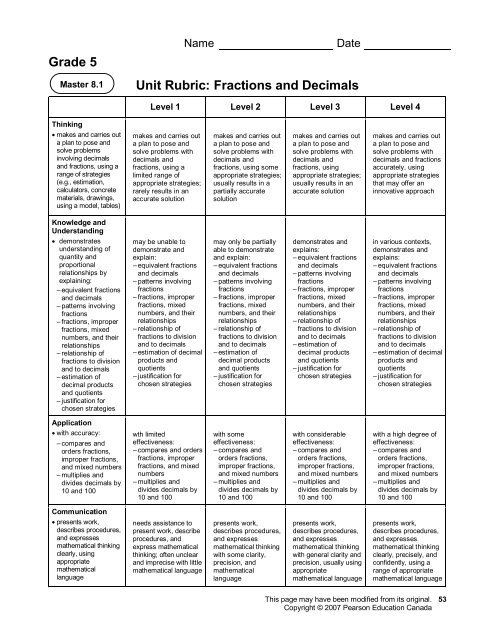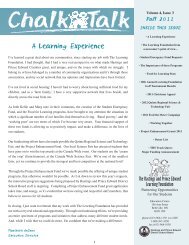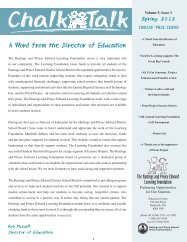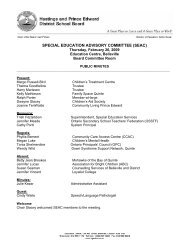Grade 5 Unit Rubric: Fractions and Decimals
Grade 5 Unit Rubric: Fractions and Decimals
Grade 5 Unit Rubric: Fractions and Decimals
Create successful ePaper yourself
Turn your PDF publications into a flip-book with our unique Google optimized e-Paper software.
<strong>Grade</strong> 5<br />
Master 8.1<br />
Thinking<br />
• makes <strong>and</strong> carries out<br />
a plan to pose <strong>and</strong><br />
solve problems<br />
involving decimals<br />
<strong>and</strong> fractions, using a<br />
range of strategies<br />
(e.g., estimation,<br />
calculators, concrete<br />
materials, drawings,<br />
using a model, tables)<br />
Knowledge <strong>and</strong><br />
Underst<strong>and</strong>ing<br />
• demonstrates<br />
underst<strong>and</strong>ing of<br />
quantity <strong>and</strong><br />
proportional<br />
relationships by<br />
explaining:<br />
– equivalent fractions<br />
<strong>and</strong> decimals<br />
– patterns involving<br />
fractions<br />
– fractions, improper<br />
fractions, mixed<br />
numbers, <strong>and</strong> their<br />
relationships<br />
– relationship of<br />
fractions to division<br />
<strong>and</strong> to decimals<br />
– estimation of<br />
decimal products<br />
<strong>and</strong> quotients<br />
– justification for<br />
chosen strategies<br />
Application<br />
• with accuracy:<br />
– compares <strong>and</strong><br />
orders fractions,<br />
improper fractions,<br />
<strong>and</strong> mixed numbers<br />
– multiplies <strong>and</strong><br />
divides decimals by<br />
10 <strong>and</strong> 100<br />
Communication<br />
• presents work,<br />
describes procedures,<br />
<strong>and</strong> expresses<br />
mathematical thinking<br />
clearly, using<br />
appropriate<br />
mathematical<br />
language<br />
Name Date<br />
<strong>Unit</strong> <strong>Rubric</strong>: <strong>Fractions</strong> <strong>and</strong> <strong>Decimals</strong><br />
Level 1 Level 2 Level 3 Level 4<br />
makes <strong>and</strong> carries out<br />
a plan to pose <strong>and</strong><br />
solve problems with<br />
decimals <strong>and</strong><br />
fractions, using a<br />
limited range of<br />
appropriate strategies;<br />
rarely results in an<br />
accurate solution<br />
may be unable to<br />
demonstrate <strong>and</strong><br />
explain:<br />
– equivalent fractions<br />
<strong>and</strong> decimals<br />
– patterns involving<br />
fractions<br />
– fractions, improper<br />
fractions, mixed<br />
numbers, <strong>and</strong> their<br />
relationships<br />
– relationship of<br />
fractions to division<br />
<strong>and</strong> to decimals<br />
– estimation of decimal<br />
products <strong>and</strong><br />
quotients<br />
– justification for<br />
chosen strategies<br />
wth limited<br />
effectiveness:<br />
– compares <strong>and</strong> orders<br />
fractions, improper<br />
fractions, <strong>and</strong> mixed<br />
numbers<br />
– multiplies <strong>and</strong><br />
divides decimals by<br />
10 <strong>and</strong> 100<br />
needs assistance to<br />
present work, describe<br />
procedures, <strong>and</strong><br />
express mathematical<br />
thinking; often unclear<br />
<strong>and</strong> imprecise with little<br />
mathematical language<br />
makes <strong>and</strong> carries out<br />
a plan to pose <strong>and</strong><br />
solve problems with<br />
decimals <strong>and</strong><br />
fractions, using some<br />
appropriate strategies;<br />
usually results in a<br />
partially accurate<br />
solution<br />
may only be partially<br />
able to demonstrate<br />
<strong>and</strong> explain:<br />
– equivalent fractions<br />
<strong>and</strong> decimals<br />
– patterns involving<br />
fractions<br />
– fractions, improper<br />
fractions, mixed<br />
numbers, <strong>and</strong> their<br />
relationships<br />
– relationship of<br />
fractions to division<br />
<strong>and</strong> to decimals<br />
– estimation of<br />
decimal products<br />
<strong>and</strong> quotients<br />
– justification for<br />
chosen strategies<br />
with some<br />
effectiveness:<br />
– compares <strong>and</strong><br />
orders fractions,<br />
improper fractions,<br />
<strong>and</strong> mixed numbers<br />
– multiplies <strong>and</strong><br />
divides decimals by<br />
10 <strong>and</strong> 100<br />
presents work,<br />
describes procedures,<br />
<strong>and</strong> expresses<br />
mathematical thinking<br />
with some clarity,<br />
precision, <strong>and</strong><br />
mathematical<br />
language<br />
makes <strong>and</strong> carries out<br />
a plan to pose <strong>and</strong><br />
solve problems with<br />
decimals <strong>and</strong><br />
fractions, using<br />
appropriate strategies;<br />
usually results in an<br />
accurate solution<br />
demonstrates <strong>and</strong><br />
explains:<br />
– equivalent fractions<br />
<strong>and</strong> decimals<br />
– patterns involving<br />
fractions<br />
– fractions, improper<br />
fractions, mixed<br />
numbers, <strong>and</strong> their<br />
relationships<br />
– relationship of<br />
fractions to division<br />
<strong>and</strong> to decimals<br />
– estimation of<br />
decimal products<br />
<strong>and</strong> quotients<br />
– justification for<br />
chosen strategies<br />
with considerable<br />
effectiveness:<br />
– compares <strong>and</strong><br />
orders fractions,<br />
improper fractions,<br />
<strong>and</strong> mixed numbers<br />
– multiplies <strong>and</strong><br />
divides decimals by<br />
10 <strong>and</strong> 100<br />
presents work,<br />
describes procedures,<br />
<strong>and</strong> expresses<br />
mathematical thinking<br />
with general clarity <strong>and</strong><br />
precision, usually using<br />
appropriate<br />
mathematical language<br />
makes <strong>and</strong> carries out<br />
a plan to pose <strong>and</strong><br />
solve problems with<br />
decimals <strong>and</strong> fractions<br />
accurately, using<br />
appropriate strategies<br />
that may offer an<br />
innovative approach<br />
in various contexts,<br />
demonstrates <strong>and</strong><br />
explains:<br />
– equivalent fractions<br />
<strong>and</strong> decimals<br />
– patterns involving<br />
fractions<br />
– fractions, improper<br />
fractions, mixed<br />
numbers, <strong>and</strong> their<br />
relationships<br />
– relationship of<br />
fractions to division<br />
<strong>and</strong> to decimals<br />
– estimation of decimal<br />
products <strong>and</strong><br />
quotients<br />
– justification for<br />
chosen strategies<br />
with a high degree of<br />
effectiveness:<br />
– compares <strong>and</strong><br />
orders fractions,<br />
improper fractions,<br />
<strong>and</strong> mixed numbers<br />
– multiplies <strong>and</strong><br />
divides decimals by<br />
10 <strong>and</strong> 100<br />
presents work,<br />
describes procedures,<br />
<strong>and</strong> expresses<br />
mathematical thinking<br />
clearly, precisely, <strong>and</strong><br />
confidently, using a<br />
range of appropriate<br />
mathematical language<br />
This page may have been modified from its original.<br />
Copyright © 2007 Pearson Education Canada<br />
53
<strong>Grade</strong> 5<br />
54<br />
Master 8.2<br />
This page may have been modified from its original.<br />
Copyright © 2007 Pearson Education Canada<br />
Name Date<br />
Ongoing Observations: <strong>Fractions</strong> <strong>and</strong> <strong>Decimals</strong><br />
The behaviours described under each heading are examples; they are not intended to be an exhaustive list of all<br />
that might be observed. More detailed descriptions are provided in each lesson under Assessment for Learning.<br />
STUDENT ACHIEVEMENT: <strong>Fractions</strong> <strong>and</strong> <strong>Decimals</strong><br />
Student Thinking Knowledge <strong>and</strong><br />
Underst<strong>and</strong>ing<br />
Makes <strong>and</strong> carries out<br />
a plan to pose <strong>and</strong><br />
solve problems<br />
involving decimals<br />
<strong>and</strong> fractions, using a<br />
range of strategies<br />
Demonstrates <strong>and</strong><br />
explains:<br />
– equivalent fractions<br />
<strong>and</strong> decimals<br />
– quantity <strong>and</strong><br />
proportional<br />
relationships<br />
(e.g., fractions <strong>and</strong><br />
decimals; improper<br />
fractions <strong>and</strong> mixed<br />
numbers)<br />
Application Communication<br />
Compares <strong>and</strong><br />
orders fractions,<br />
improper fractions,<br />
<strong>and</strong> mixed numbers<br />
Multiplies <strong>and</strong> divides<br />
decimals by 10 <strong>and</strong><br />
100<br />
Expresses<br />
mathematical thinking<br />
clearly, using<br />
appropriate terminology<br />
Presents work clearly<br />
Level 1 – limited; Level 2 – some/somewhat; Level 3 – considerable effectiveness; Level 4 – high degree of effectiveness
<strong>Grade</strong> 5<br />
Master 8.3<br />
Thinking<br />
• uses critical/creative<br />
processes (e.g.,<br />
making <strong>and</strong> carrying<br />
out a plan) to<br />
successfully:<br />
– satisfy guidelines for<br />
the creation of a<br />
garden<br />
– solve problems<br />
posed by<br />
classmates<br />
– pose story problems<br />
involving<br />
multiplication <strong>and</strong><br />
division with decimals<br />
Knowledge <strong>and</strong><br />
Underst<strong>and</strong>ing<br />
• shows<br />
underst<strong>and</strong>ing of<br />
quantity <strong>and</strong><br />
proportion (e.g.,<br />
fractions <strong>and</strong><br />
decimals) by using<br />
concepts related to<br />
fractions, decimals,<br />
<strong>and</strong> their<br />
relationships, <strong>and</strong><br />
recognizing when<br />
results are<br />
reasonable<br />
Application<br />
• with accuracy:<br />
– represents fractions<br />
as regions of a<br />
rectangle (using grid<br />
paper)<br />
– describes regions of<br />
a rectangle (on grid<br />
paper) as decimals<br />
– relates fractions <strong>and</strong><br />
decimals<br />
– multiplies <strong>and</strong><br />
divides decimals<br />
Communication<br />
• presents work<br />
clearly, using<br />
appropriate<br />
mathematical<br />
terminology,<br />
numbers, <strong>and</strong><br />
symbols (e.g.,<br />
decimal point)<br />
Name Date<br />
Performance Assessment <strong>Rubric</strong>:<br />
In the Garden<br />
Level 1 Level 2 Level 3 Level 4<br />
uses critical/creative<br />
processes to solve <strong>and</strong><br />
create problems<br />
involving fractions <strong>and</strong><br />
decimals with limited<br />
success<br />
shows very limited<br />
underst<strong>and</strong>ing; uses<br />
few concepts related to<br />
fractions <strong>and</strong> decimals<br />
with limited<br />
effectiveness:<br />
– represents<br />
fractions as<br />
regions of a<br />
rectangle<br />
– describes regions<br />
of a rectangle as<br />
decimals<br />
– relates fractions<br />
<strong>and</strong> decimals<br />
– multiplies <strong>and</strong><br />
divides decimals<br />
presents work with<br />
little clarity; uses few<br />
appropriate<br />
mathematical terms<br />
<strong>and</strong> symbols<br />
uses critical/creative<br />
processes to solve<br />
<strong>and</strong> create problems<br />
involving fractions <strong>and</strong><br />
decimals with some<br />
success<br />
shows limited<br />
underst<strong>and</strong>ing by<br />
using some concepts<br />
related to fractions<br />
<strong>and</strong> decimals<br />
with some<br />
effectiveness:<br />
– represents<br />
fractions as<br />
regions of a<br />
rectangle<br />
– describes regions<br />
of a rectangle as<br />
decimals<br />
– relates fractions<br />
<strong>and</strong> decimals<br />
– multiplies <strong>and</strong><br />
divides decimals<br />
presents work with<br />
some clarity; uses<br />
some appropriate<br />
mathematical terms<br />
<strong>and</strong> symbols<br />
uses critical/creative<br />
processes to solve <strong>and</strong><br />
create problems<br />
involving fractions <strong>and</strong><br />
decimals successfully<br />
shows underst<strong>and</strong>ing<br />
by using relevant<br />
concepts related to<br />
fractions <strong>and</strong> decimals<br />
with considerable<br />
effectiveness:<br />
– represents<br />
fractions as regions<br />
of a rectangle<br />
– describes regions<br />
of a rectangle as<br />
decimals<br />
– relates fractions<br />
<strong>and</strong> decimals<br />
– multiplies <strong>and</strong><br />
divides decimals<br />
presents most work<br />
clearly <strong>and</strong> precisely;<br />
uses appropriate<br />
mathematical terms<br />
<strong>and</strong> symbols<br />
uses critical/creative<br />
processes to solve <strong>and</strong><br />
create problems<br />
involving fractions <strong>and</strong><br />
decimals successfully<br />
<strong>and</strong> effectively<br />
shows thorough<br />
underst<strong>and</strong>ing by using<br />
all relevant concepts<br />
related to fractions <strong>and</strong><br />
decimals<br />
with a high degree of<br />
effectiveness:<br />
– represents fractions<br />
as regions of a<br />
rectangle<br />
– describes regions of<br />
a rectangle as<br />
decimals<br />
– relates fractions<br />
<strong>and</strong> decimals<br />
– multiplies <strong>and</strong> divides<br />
decimals<br />
presents all work<br />
clearly, precisely, <strong>and</strong><br />
confidently; uses a<br />
range of appropriate<br />
mathematical terms <strong>and</strong><br />
symbols with precision<br />
This page may have been modified from its original.<br />
Copyright © 2007 Pearson Education Canada<br />
55
<strong>Grade</strong> 5<br />
56<br />
Master 8.4<br />
This page may have been modified from its original.<br />
Copyright © 2007 Pearson Education Canada<br />
Name Date<br />
<strong>Unit</strong> Summary: <strong>Fractions</strong> <strong>and</strong> <strong>Decimals</strong><br />
Review assessment records to determine the most consistent achievement levels for the assessments<br />
conducted. Some cells may be blank. Overall achievement levels may be recorded in each row, rather<br />
than identifying levels for each achievement category.<br />
Str<strong>and</strong>:<br />
Number Sense <strong>and</strong><br />
Numeration<br />
Ongoing Observations<br />
Strategies Toolkit<br />
(Lesson 10)<br />
Work samples or<br />
portfolios; conferences<br />
Show What You Know<br />
<strong>Unit</strong> Test<br />
<strong>Unit</strong> Problem<br />
In the Garden<br />
*Use Ontario Achievement Levels 1, 2, 3, 4.<br />
SelfAssessment:<br />
Thinking Knowledge<br />
<strong>and</strong><br />
Underst<strong>and</strong>ing<br />
Comments: (Strengths, Needs, Next Steps)<br />
Most Consistent Level of Achievement*<br />
Achievement Level for reporting<br />
Application Communication Overall
















